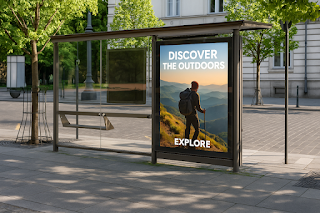
You’ve probably seen it or maybe lived it.
You spend weeks prepping for a trade show. The team’s locked in. The products are polished. The sales strategy is tight.
Then you show up and realize... your booth looks just like everyone else’s.
You’ve got a table. A banner. Some printed handouts. Nothing’s wrong with it, but nothing’s making people stop either. Meanwhile, a competitor two aisles down is packed with attendees, taking selfies in front of their backdrop, posting photos, and drawing traffic.
Here’s the hard truth: most booths fail before the show even begins. Not because the brand isn’t great. But because the display wasn’t built to do its job: turn heads, pull people in, and start the conversation.
Let’s fix that.
Most Booths Use Banners and Table Covers. The Smart Ones Use Them Strategically.
Banners and table covers are the backbone of a trade show setup, and there's nothing wrong with using them. In fact, when they’re done well, they’re some of the most effective tools you’ve got.
But here’s the difference: most companies treat them like an afterthought. A logo here, some text there, and call it done.
Smart brands treat them like assets. They use high-quality fabric that resists wrinkles under show lighting, bold, benefit-driven messaging, and layouts that are easy to read from a distance. They pair their banners with clean, branded table covers that make the whole setup feel intentional, not improvised.
And when those elements are combined with floor graphics, backdrops, or signage that adds height or dimension? That’s when your booth starts working harder than the people standing in it.
It’s not about reinventing the wheel. It’s about executing the essentials better than everyone else.
Don’t Just Show Up. Make Your Booth Work Like a Sales Rep.
Think about it this way: your booth is your first impression. It’s a handshake before the handshake. If the messaging isn’t clear, if it takes more than three seconds to understand what you do, people keep walking.
A well-executed banner or backdrop doesn’t just display your name. It communicates what problem you solve and why someone should care. That’s the job. Visual hierarchy, bold headlines, and clear CTAs aren’t just design choices. They’re conversion tools.
And Then There’s the Practical Side...
This is what no one talks about until it’s too late: the setup.
A booth that takes two hours to build is a drain on your team. A flimsy banner that tears in transit won’t just cost you money—it’ll stress you out the night before the show opens.
That’s why the best trade show print displays today are built for real life. They’re modular. Easy to carry. Durable. They come with carry cases. The hardware matters just as much as the visuals.
And yes—when you’re working with a printer who specializes in trade show displays, these are the kinds of things we plan for.
Innovation Doesn’t Mean Complicated
Let’s clear something up. “Innovative” doesn’t mean techy, flashy, or expensive. It means effective.
Sometimes, it’s switching from a matte to a UV coating so your signage pops under artificial lighting. Sometimes, it’s using cut-to-shape rigid signs instead of another square panel. Sometimes, it’s adding a QR code in the right spot to move people from offline to online seamlessly.
Innovation is about knowing what works for the space, the audience, and the message, and making sure every print element earns its place.
Let’s Build a Booth That Stops People in Their Tracks
If your next event is coming up and you’re still trying to make last year’s banner do the job, let’s talk.
We’ll help you reimagine your display with print products that actually get attention—banners, backdrops, floor decals, signage, and whatever else makes sense for your space and your goals.
No fluff. No gimmicks. Just smart print, done right.








